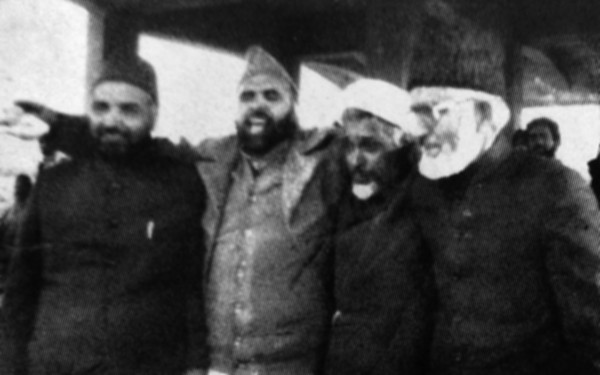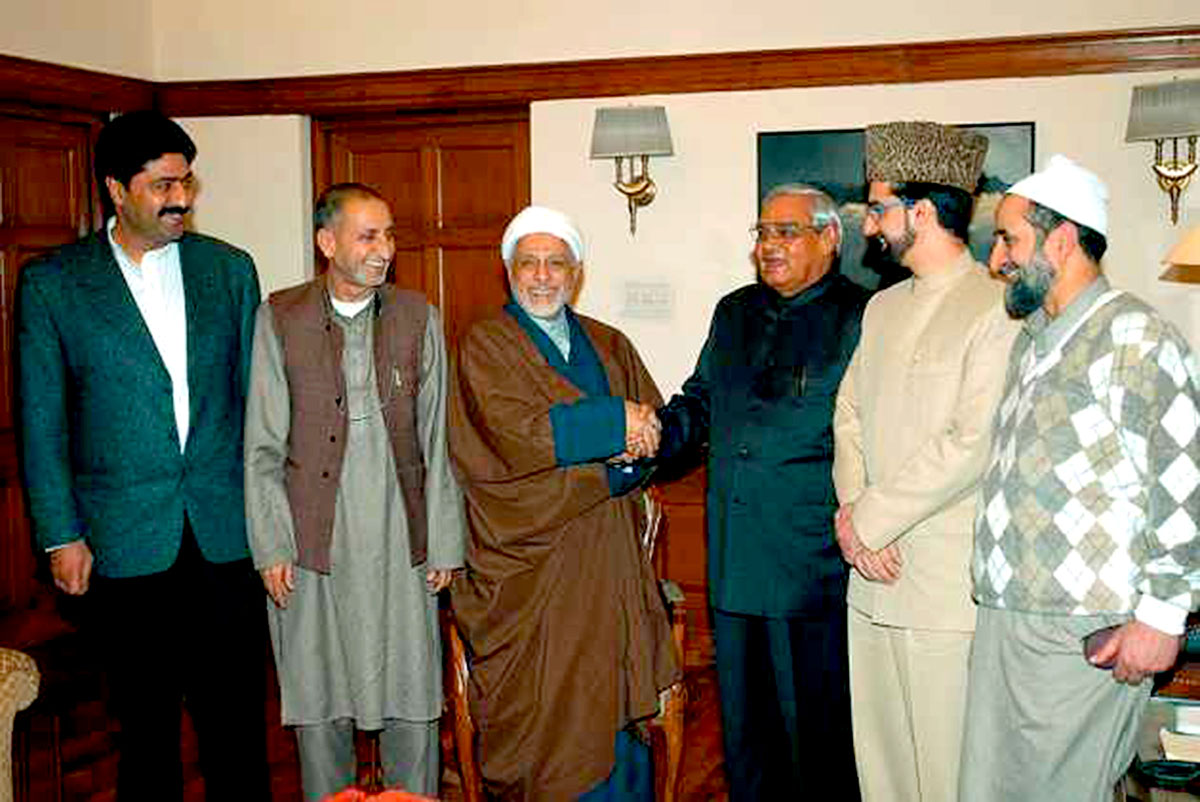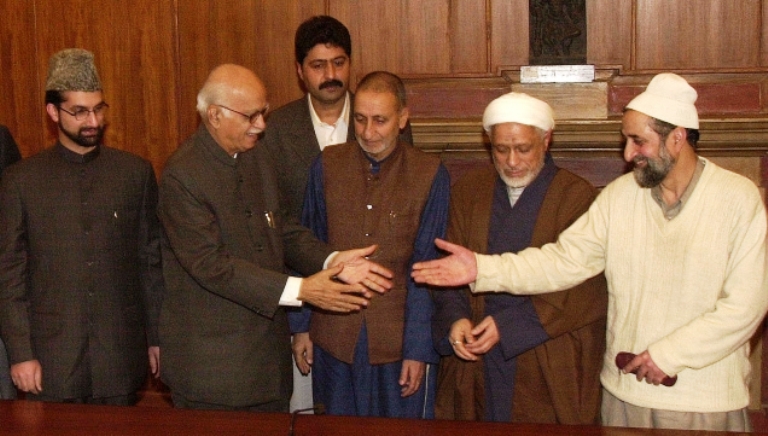After a prolonged illness, Moulana Abbas Ansari passed away at the age of 86. Masood Hussain offers the different facets of a well-read cleric who dedicated his life to Muslim unity in Kashmir while living a life of his own choice
On October 25, 2022 afternoon, thousands of people bid adieu to Moulana Mohammad Abbas Ansari, one of Kashmir’s well-known clerics and political activists, who once headed the All Party Hurriyat Conference. Ansari, 86, was unwell for most of the years after he retired from active politics in 2010 and, off late, was intermittently hospitalised. He breathed his last at his ancestral residence in Khanqah-e-Sokhta (NawaKadal).
Born on August 18, 1936, in a religious family, Ansari’s father Molvi Hasan Ali Ansari (January 1912) – December 1993) was his era’s master MarsiaKhawan, who once led the Shia Auqaf in Kashmir. Hasan Ali invested massively in the education of his children, Abbas and Mustafa, who later became religious leaders.
AbbasAnsari initially picked the basics of his education from home and later went to the local schools. He graduated from the Oriental College Srinagar and in 1950, he joined Sultan-ul-Madaris in Lucknow for religious studies. In 1954, he proceeded to Iraq and joined Najaf-i-Ashraf where he studied for eight years.
His first activity after his return from Iraq was to start publishing a religious magazine Safeena, a monthly periodical that survived for various decades. On March 27, 1962, Ansari founded Anjuman-e-Ittehadul Muslimeen with a focus on bridging the gulf between the Sunni and Shia sections and contributing towards the movement for Muslim unity.
Long Career
In his long career, Ansari has had three prominent roles in Kashmir politics. Firstly, during the holy relic agitation, he was an active participant in the agitation and moved the Shia sect into the mass demand for the restoration of the holy relic. Secondly, he was the convenor of the Muslim United Front (MUF), an alliance that changed Kashmir forever. Finally, he once headed the All Party Hurriyat Conference. However, the extremely moderate and flexible cleric’s outstanding contribution has remained to be a strong votary of the sectarian unity among the Muslims of Jammu and Kashmir.
Though focused on neutralising the sectarian crisis, Ansari could not stay away from the politics of the lace. However, his priorities shifted with the passage of time. Initially, he worked with the National Conference, later was part of the Plebiscite Front, was part of MUF and eventually landed in Hurriyat.
Holy Relic Agitation
Within a few years after his return from Iraq, Ansari landed in a situation that brought him to prominence for the first time. He was the main leader who mobilised the Shia Muslims for the mass agitation for the return of the holy relic from the Hazratbal shrine.
The relic went missing on December 27, 1963, and triggered mass unrest across Jammu and Kashmir. Various parts of the Indian subcontinent got involved with almost 400 people dying in West Bengal and East Pakistan (now Bangladesh). “Ansari sahib was a fierce orator and he would be seen almost everywhere,” Imdad Saqi, a journalist who knows Ansari said. “He was arrested and later became the top leader of the Holy Relic Movement.” He became the Coordinator of the Movement.
A year after the Holy Relic agitation, Ansari joined hands with Sofi Mohammad Akbar and constituted the Peoples Action Committee with a focus on the wider politics of Kashmir. It so happened while the Plebiscite Front – the name with which the original National Conference was working after the title head had literally been taken by Bakhshi Ghulam Mohammad with him as early as 1953.
Despite being a pro-Sheikh man, he had a series of disagreements with him and his politics. These differences were reflective of his frequent walkouts from State Political Convention. He was a key player in the floating of the People’s United Front against the Indira Gandhi – Sheikh Abdullah accord of 1975. It, however, fizzled out within days after making a few news items.
The MUF Era
The creation of the Muslim United Front (MUF) started with the sacking of employees by the then governor Jagmohan in 1986. When the initial response was generated, Ansari was part of it. It was the formation of the Muslim Employees Front co-piloted by Prof Abdul Gani Bhat that eventually led to the making of MUF. Ansari eventually became its Convenor and in March 1987 assembly elections, his party had four candidates in the fray including his brother. However, none of them could succeed in reaching the legislative assembly, partly because of the mass rigging that National Conference and Congress alliance resorted to.

With Dr Farooq Abdullah led alliance back in power, the MUF disintegrated. As most of its frontline leaders were jailed, those free failed to manage the massive goodwill that the MUF had earned in the shortest possible time. Ansari could not prevent its disintegration. Post-poll, in absence of its key leaders, MUF was expanded with Ghulam Mohammad Shah, and Abdul Gani Lone included. Tensions remained and eventually, Ansari expelled Jamaat-e-Islami from MUF and also disowned the four lawmakers that it had succeeded in getting to the assembly. The expulsion was announced by Ansari in a press conference on June 11, 1988.
However, the MUF had ceased to exist already. The frustrated youth were desperate to react. Ansari knew the ground realities. “Anti-India sentiment in Kashmir is going to explode,” Abbas Ansari told the media on March 27, 1987, within days after the election results were out and most of MUF leaders were in jail. “We are not in a position to stop it.”
Militancy and Hurriyat
By late 1989, militancy has erupted across Kashmir. The government started acting fast and most of the MUF leaders were jailed. On April 13, 1990, Ansari was arrested under the Public Safety Act. He was initially retained in Badami Bagh, later moved to Jammu, then to Jodhpur and Tihar and finally, most of the political class was retained in a special jail in Delhi’s Mehrauli.

With most of the separatists in jail and almost the entire mainstream camp out in Jammu and Delhi, Kashmir lacked the political class. It was in this backdrop that separatist leaders were set free on April 13, 1992. They flew jointly to Srinagar and the government permitted the media to cover their release. It eventually led to the constitution of a separatist alliance called the All Party Hurriyat Conference (APHC) with Mirwaiz Umer Farooq – who was not jailed, as its founding Chairman on July 31, 1993. Ansari was one of the seven executive members of the 26-party separatist alliance. He had the support of the militant outfit Hizb ul Moomineen.
On July 12, 2003, Ansari became a consensus choice to be the fourth chairman of the alliance. It was Hurriyat’s most challenging period. Though the hawk-dove divide was already there, the crisis was triggered by the 2002 assembly elections that led the PDP-Congress alliance to form the government. As part of its “healing touch” policy, the Mufti Sayeed-led government released Syed Ali Geelani. Post-surgery, when he reached home, he levelled two allegations against the Hurriyat. First, they skipped a poll boycott campaign unlike in 1996. Second, they must act against a constituent of Hurriyat that contested polls using the proxy candidate. It was a reference towards the Jammu and Kashmir Peoples’ Conference(PC) that had fielded proxy candidates.

“They (PC) have already expelled the one (Ghulam Mohiuddin Sofi, now a minister) from the party for contesting the elections,” Ansari told reporters within hours after his elevation to the top separatist post. “We cannot expel the party for him and if it is so then Khaliq Hanief, a close associate of Geelani, also contested the elections. Should Jamaat be expelled for that?”
Geelani made this alleged inaction of the Hurriyat the reason for the vertical split of the alliance. He founded his own Hurriyat in September 2003. The split created an interesting situation. What one faction would seek, another would religiously oppose it. Hurriyat (moderate) called for the re-opening of the Srinagar-Muzaffarabad Road and the Hurriyat (hawk) wrote to Islamabad against it. Moderates opted for an engagement with Delhi, hawks went hammer and tongs against the sell-out. While Ansari-led Hurriyat was very supportive of Islamabad’s moves towards Delhi (read Musharraf formula), Geelani literally fought with the dictator in a meeting in Delhi.
Ansari’s leadership, however, was the most eventful era of the alliance. In 2004, they had a series of meetings with the BJP-led NDA government in Delhi. They had meetings with LK Advani, the Deputy Prime Minister (January 22, 2004) and Atal Behari Vajpayee, the Prime Minister. Engaging with the government was brave especially in wake of the alliance losing one of its key executive members, Abdul Gani Lone to the militant assassination on July 21, 2002. When the Jhelum Valley Road was opened, Ansari led a delegation to the other side of Kashmir in June 2005. Between 1994 and 2000, Ansari flew abroad many times and attended at least two meetings of the Organisation of Islamic Cooperation (OIC) Contact Group on Kashmir.
Throughout his political career, Ansari was not only moderate but hugely flexible. He never closed the idea of interaction. Even in 2010, when the Hurriyat had decided against the idea of meeting the interlocutors, Ansari opened the door for them Dileep Padgaonker and Radha Kumar. This led to a temporary suspension of his party from the alliance for some time. It was only after that Ansari took retirement from active politics and restricted himself to his home.
Sectarian Unity
Politics apart, Ansari had literally dedicated himself to the idea of unity amongst Muslims divided by sects. He would frequently be seen offering prayers in the Sunni mosques following the local Imam. Many times, he spoke from the pulpits of the Jamia Masjid in Srinagar.
The people who know Ansari closely said his first major initiative was the observance of the Youm-e-Hussain – the day of Imam-e-Hussain – in the lawns of Khanqah-e-Moala, Srinagar. The function was attended by Sheikh Mohammad Abdullah, Molvi Mohammad Sayeed Masoodi, Mirwaiz Mohammad Yasin Hamdani and Molvi Mohammad Farooq. He always had a close relationship with Mirwaiz Mohammad Farooq which had started from the Holy Relic agitation days. Besides, he would lead a Muhamrram mourning procession on the eighth of Muharram that would start from Shaheed Gunj and conclude within the laws of Khanqah.
Molvi sahib, one of his followers said, always believed that the powerful and the greedy would always divide Kashmir on basis of their sects and make them fight with each other so that they become rulers and judges. “This is something he always worked against,” he said.
At the same time, he has contributed to education. In north Kashmir’s most educationally backward areas, he has been successfully running a chain of Madina Public Schools, which have significant contributions in improving literacy, people in the know of things said.
During his life, Ansari was jailed almost nine times. It had started during the holy relic agitation. His longest spell was in the 1990s. A prolific writer, Ansari has authored many books including his autobiography, Khare Gulistan. His death was widely mourned and his funeral was the first well-attended one, especially of a separatist, that found no intervention by the government, a first since 2019.















